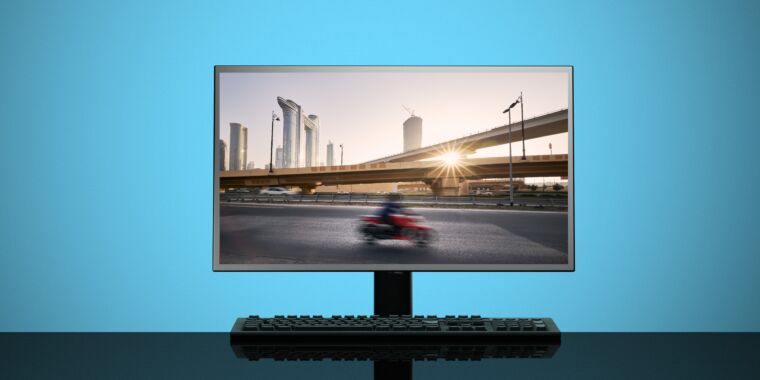Let’s say you’re buying a new PC monitor, TV, or laptop and want an idea of how clear fast movement would appear on it. What information would you consider? Specs like response time and refresh rate provide an idea of display speed. But if you think about it, a measurement of time isn’t a particularly straightforward answer to the question of, “How much motion blur will I see?” In response, the Video Electronics Standards Association (VESA), which makes other display standards, including DisplayPort and Adaptive-Sync, today announced a new specification program that puts a label on displays quantifying their expected motion blur performance.
The Clear Motion Ratio Compliance Test Specification (ClearMR) is a standard and logo program for consumer displays, including PC monitors, TVs, laptops, tablets, and all-in-ones (several products are already certified). It introduces a series of tiers with a numerical value that’s supposed to indicate to consumers the display’s ratio of clear pixels to blurry ones during fast-paced movement. For example, ClearMR 7000, which has a “Clear Motion Ratio” range of 6,500 to 7,500, means the display would have a clear-to-blurry ratio of 65–75:1 or 65–75 times more clear pixels than blurry ones.
| VESA ClearMR Tier | Clear Motion Ratio (CMR) Range |
|---|---|
| ClearMR 3000 | 2,500 ≤ CMR < 3,500 |
| ClearMR 4000 | 3,500 ≤ CMR < 4,500 |
| ClearMR 5000 | 4,500 ≤ CMR < 5,500 |
| ClearMR 6000 | 5,500 ≤ CMR < 6,500 |
| ClearMR 7000 | 6,500 ≤ CMR < 7,500 |
| ClearMR 8000 | 7,500 ≤ CMR < 8,500 |
| ClearMR 9000 | 8,500 ≤ CMR |
In an interview with Ars Technica, Dale Stolitzka, senior principal researcher at Samsung Display’s America R&D Lab and lead contributor to ClearMR, said that VESA settled on ClearMR 3000 as the lowest tier befitting laptops with screens in the 90–120 Hz range. Displays that are 60 Hz would typically not qualify for ClearMR certification.
ClearMR 9000, meanwhile, represents the best performance but leaves room for improvement, as you can see in the images below:
VESA VESA VESA VESA 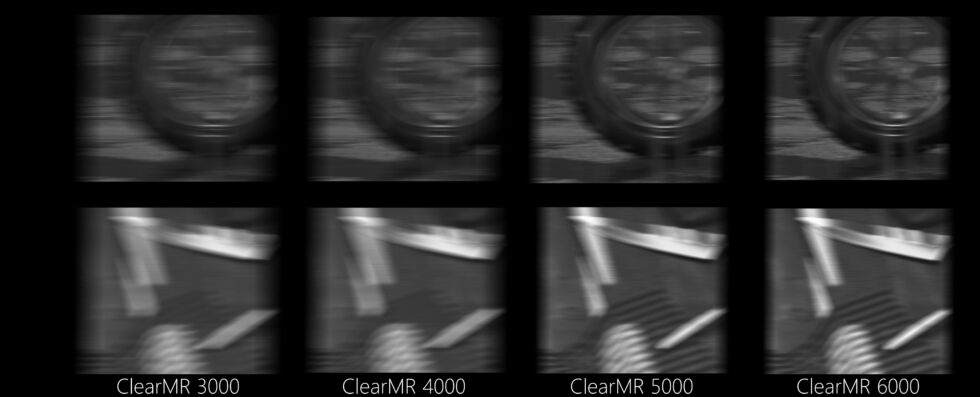
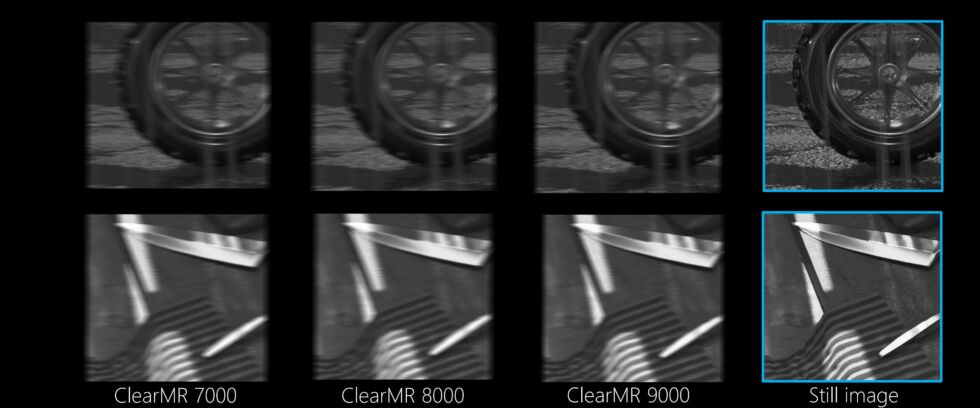
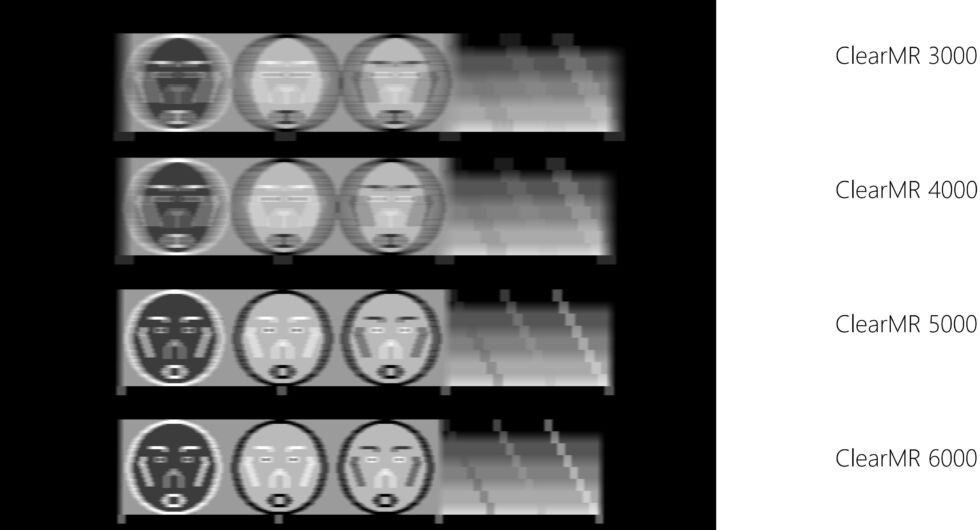
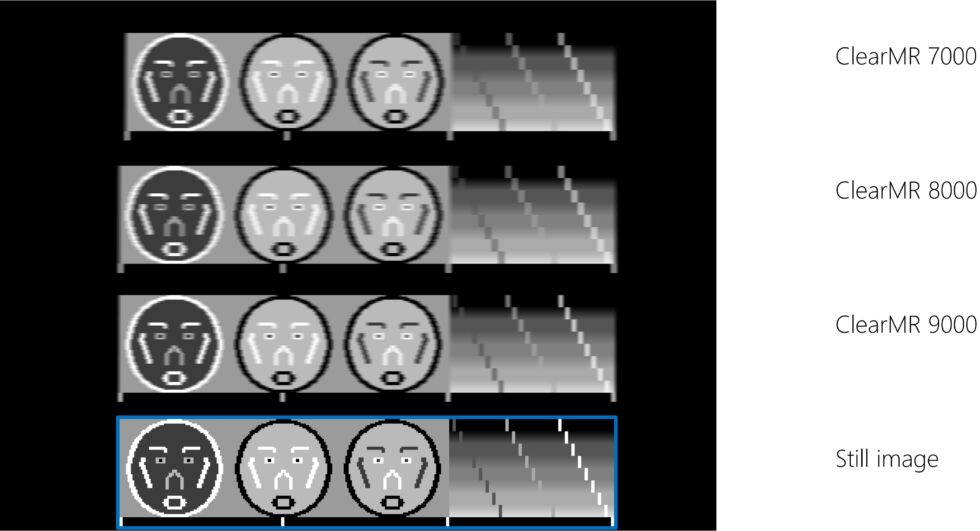
VESA’s member list is a long one, including the likes of Intel, Samsung, AU Optronics, LG Display and Electronics, and Lenovo, so you can expect thorough and complex testing methodologies. That includes setting a speed at which VESA measures blur. ClearMR testing includes measurements of a test pattern moving across the screen at 15 degrees per second, which Stolitzka said is about the amount of time it takes for an object to move across a screen in approximately four seconds.
While that’s pretty fast, including for gaming, it doesn’t equate to “one big blur,” as Stolitzka put it. “Most” non-action movies won’t have motion that fast, he noted, while some games, like first-person shooters and strategy games, may have faster motion.
ClearMR vs MPRT or GtG response time
VESA believes ClearMR paints a more informative picture of potential motion blur than looking at response time specs, be it motion picture response time (MPRT) or gray-to-gray (GtG).
“It is our goal that ClearMR will replace existing metrics that are used in advertisements for blur-based metrics that are solely based on time, like MPRT. I would be perfectly happy if I didn’t see that in advertisements anymore,” Stolitzka said.
According to VESA’s announcement, MPRT, which measures how long it takes for a display to change pixels from black to white and then to black, isn’t sufficient for characterizing blur because it’s based on time alone and “cannot account for a number of image enhancement and blur mitigation techniques, such as excessive overshoot and undershoot, which can create artifacts and distortions that negatively impact image quality.”
Further, MPRT, as well as GtG response time, only measures from 10 percent of the transition to 90 percent.
GtG response, which many vendors, especially gaming monitor ones, list in lieu of MPRT, measures the amount of time it takes a pixel to change from one shade of gray to another, but vendors cherry-pick those results. And you don’t know what specific transition points a vendor used for their GtG measurement. For example, it could be presenting the average transition time (again, 10–90 percent of that transition) from light gray to dark gray, or mid-gray to light gray, or white to black, as examples.
ClearMR certification tests displays at an ambient room temperature of between 72.5° and 76° Fahrenheit with the display at default settings, native resolution, max refresh rate, and backlight strobing (if available) disabled.
A bar with different luminances moves across a small box on the display and is measured with a camera at a fixed location equal to 1.5 times the height of the display being tested. Multiple frames are shot to create a composite image, providing an idea of what the user would see when blur moves across the screen.
The specification also accounts for displays that use overdrive to increase response time. Overdrive can reduce motion blur but can also result in visual artifacts, like ghosting and coronas (check out BlurBusters for some good examples). So, VESA limits overshoot to under 20 percent and undershoot to under 10 percent.
Currently, ClearMR only pertains to SDR content, but VESA said HDR support will come in the near future.
Until then, the ClearMR will offer a way for vendors to provide a standardized way of characterizing SDR motion blur in a way that’s easier for the mind to translate into real-life use. It also provides a way for vendors to discuss motion blur performance in the same language.
